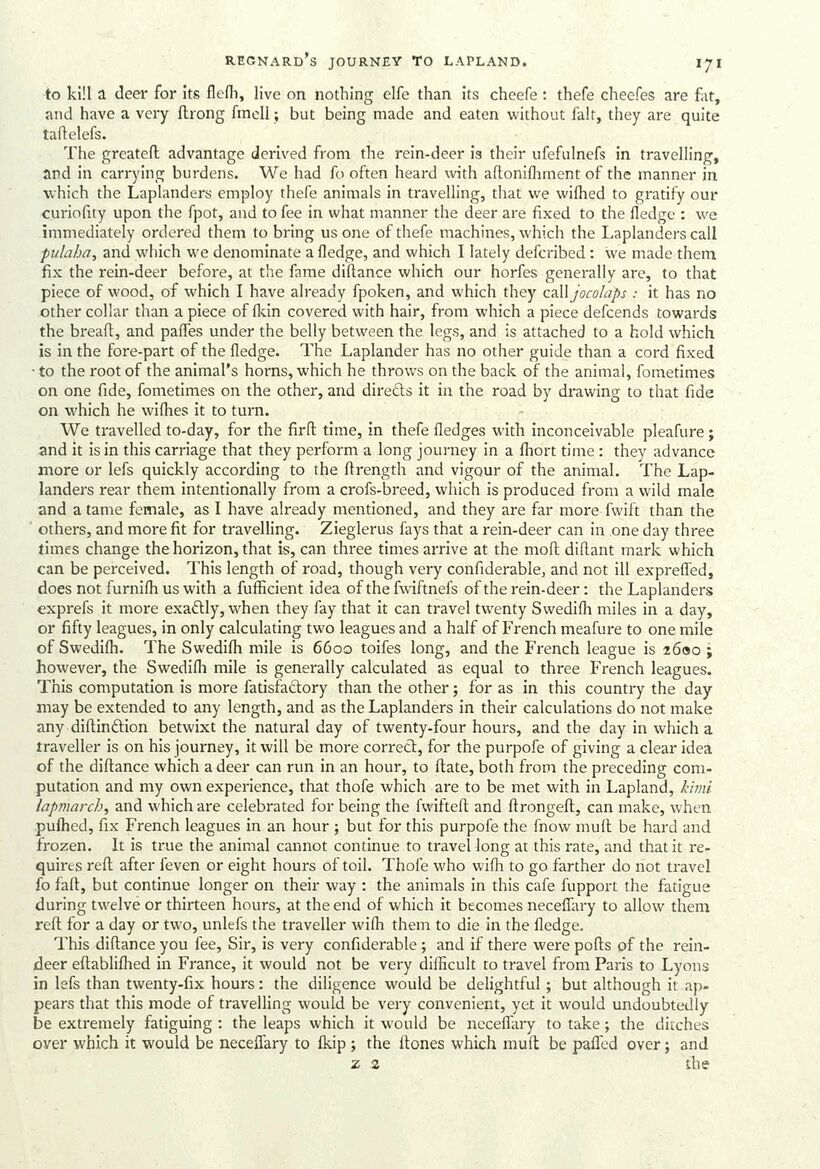
Full resolution (JPEG) - On this page / på denna sida - Pages ...

<< prev. page << föreg. sida << >> nästa sida >> next page >>
Below is the raw OCR text
from the above scanned image.
Do you see an error? Proofread the page now!
Här nedan syns maskintolkade texten från faksimilbilden ovan.
Ser du något fel? Korrekturläs sidan nu!
This page has never been proofread. / Denna sida har aldrig korrekturlästs.
REGNARD’S JOURNEY TO LAPLAND. VI
to kill a deer for its flefh, live on nothing elfe than its cheefe: thefe cheefes are fat,
and have a very ftrong fmell; but being made and eaten without falt, they are quite
taftelefs.
The greateft advantage derived from the rein-deer is their ufefulnefs in travelling,
and in carrying burdens. We had fo often heard with aftonifhment of the manner in
which the Laplanders employ thefe animals in travelling, that we wifhed to gratify our
curiofity upon the fpot, and to fee in what manner the deer are fixed to the fledge: we
immediately ordered them to bring us one of thefe machines, which the Laplanders call
pulaha, and which we denominate a fledge, and which I lately defcribed: we made them
fix the rein-deer before, at the fame diftance which our horfes generally are, to that
piece of wood, of which I have already fpoken, and which they call joco/aps : it has no
other collar than a piece of fkin covered with hair, from which a piece defcends towards
the breaft, and paffes under the belly between the legs, and is attached to a kold which
is in the fore-part of the fledge. The Laplander has no other guide than a cord fixed
-to the root of the animal’s horns, which he throws on the back of the animal, fometimes
on one fide, fometimes on the other, and directs it in the road by drawing to that fide
on which he wifhes it to turn. ;
We travelled to-day, for the firft time, in thefe fledges with inconceivable pleafure ;
and it isin this carriage that they perform a long journey in a fhort time: they advance
more or lefs quickly according to the ftrength and vigour of the animal. The Lap-
landers rear them intentionally from a crofs-breed, which is produced from a wild male
and a tame female, as I have already mentioned, and they are far more {wift than the
others, and more fit for travelling. Zieglerus fays that a rein-deer can in one day three
times change the horizon, that is, can three times arrive at the moft diftant mark which
can be perceived. This length of road, though very confiderable, and not ill exprefled,
does not furnifh us with a fufficient idea of the fwiftnefs of the rein-deer: the Laplanders
exprefs it more exactly, when they fay that it can travel twenty Swedith miles in a day,
or fifty leagues, in only calculating two leagues and a half of French meafure to one mile
of Swedifh. The Swedifh mile is 6600 toifes long, and the French league is 2600 5
however, the Swedifh mile is generally calculated as equal to three French leagues.
This computation is more fatisfactory than the other; for as in this country the day
may be extended to any length, and as the Laplanders in their calculations do not make
any diftinction betwixt the natural day of twenty-four hours, and the day in whicha
traveller is on his journey, it will be more correct, for the purpofe of giving a clear idea
of the diftance which a deer can run in an hour, to ftate, both from the preceding com-
putation and my own experience, that thofe which are to be met with in Lapland, fini
lapmarch, and whichare celebrated for being the {wifteft and ftrongeft, can make, when
puthed, fix French leagues in an hour ; but for this purpofe the {now muft be hard and
frozen. It is true the animal cannot continue to travel long at this rate, and that it re-
quires reft after feven or eight hours of toil. Thofe who with to go farther do not travel
fo faft, but continue longer on their way: the animals in this cafe fupport the fatigue
during twelve or thirteen hours, at the end of which it becomes neceflary to allow them
reft for a day or two, unlefs the traveller with them to die in the fledge.
This diftance you fee, Sir, is very confiderable ; and if there were pofts of the rein-
deer eftablifhed in France, it would not be very difficult to travel from Paris to Lyons
in lefs than twenty-fix hours: the diligence would be delightful ; but although it ap-
pears that this mode of travelling would be very convenient, yet it would undoubtedly
be extremely fatiguing : the leaps which it would be neceflary to take; the ditches
over which it would be neceflary to fkip; the ftones which mutt be pafled over; and
Z2 the
<< prev. page << föreg. sida << >> nästa sida >> next page >>